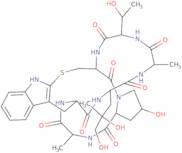
Phalloidin
CAS: 17466-45-4
Ref. 3D-FP72056
| 1mg | A consultar | ||
| 2mg | A consultar | ||
| 5mg | A consultar | ||
| 10mg | A consultar | ||
| 500µg | A consultar |
Información del producto
- Phalloidin, Amanita phalloides
- 29-(2,3-dihydroxy-2-methylpropyl)-2-hydroxy-23-(1-hydroxyethyl)-6,26-dimethyl-1,2,3,3a,5,6,8,9,10,15-decahydro-17H-18,9-(epiminoethanoiminoethanoiminoethanoiminomethano)pyrrolo[1',2':5,6][1,5,8,11]thiatriazacyclopentadecino[15,14-b]indole-4,7,19,22,25,28,31(18H)-heptone
- (2S,3aS,6S,9S,18R,23R,26S,29S)-29-[(2R)-2,3-dihydroxy-2-methylpropyl]-2-hydroxy-23-[(1S)-1-hydroxyethyl]-6,26-dimethyl-1,2,3,3a,5,6,8,9,10,15-decahydro-17H-18,9-(epiminoethanoiminoethanoiminoethanoiminomethano)pyrrolo[1',2':5,6][1,5,8,11]thiatriazacyclopentadecino[15,14-b]indole-4,7,19,22,25,28,31(18H)-heptone
Phalloidin is a cell-permeable, cationic fluorescent dye that binds to the cytoskeletal protein actin and stains nuclei in cells. It has been used as a marker for the identification of cell nuclei or in biological studies of kidney fibrosis. Phalloidin has also been shown to be effective against matrix effect in cultured cells. The rate constant for phalloidin binding to actin is dependent on the pH of the solution, with higher concentrations found at lower pH values. The chemical structure of phalloidin consists of three components: a benzene ring, an amino group and a carboxyl group. When phalloidin is exposed to cytochalasin B, p2y receptors are inhibited and this inhibits enzyme activities such as adenylate cyclase activity and phospholipase activity. This inhibition can lead to toxicological effects on cells such as apoptosis induction or necrosis induction.
Propiedades químicas
Consulta técnica sobre: 3D-FP72056 Phalloidin
Si desea solicitar un presupuesto o realizar un pedido, por favor añada los productos deseados a su carrito y solicite un presupuesto o pedido desde el carrito. Es más rápido, más barato, y podrá beneficiarse de los descuentos y las ventajas disponibles.





